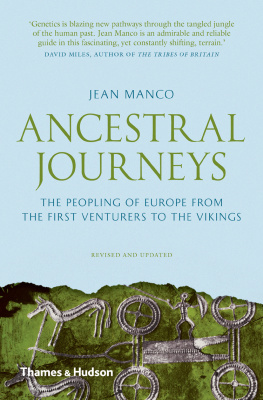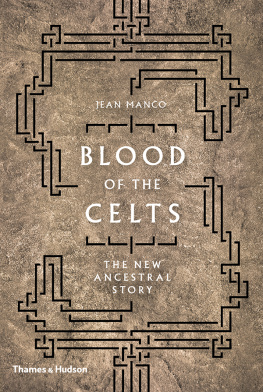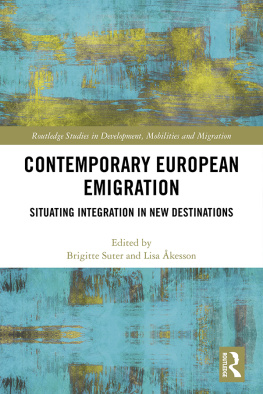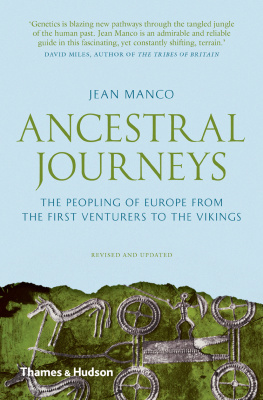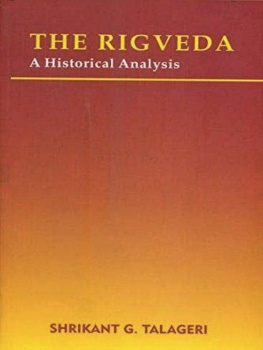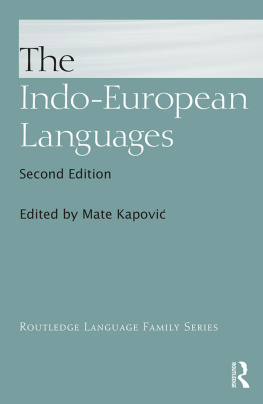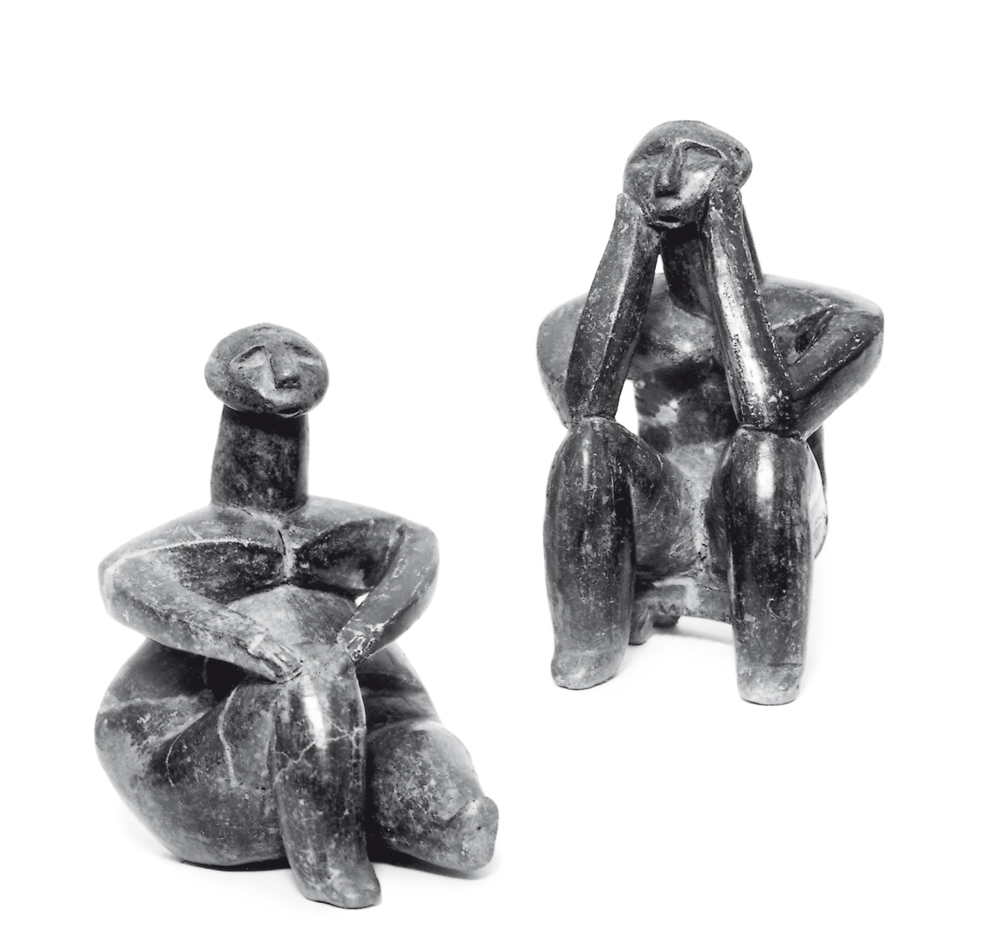
Frontispiece Neolithic figurines from Cernavoda, Romania, late 4th millennium BC.

About the Author
Jean Manco is a building historian with an inter-disciplinary approach, having been trained within an archaeological unit. She has taught at Plymouth and Bristol universities. Her previous publications include building, town, parish and charity histories. More recently she has pursued her wider interests in genetics, linguistics and the prehistory of Europe.
Other titles of interest published by
Thames & Hudson include:
The Complete World of Human Evolution
Exploring the World of the Vikings
The Historical Atlas of the Celtic World
The Human Past: World Prehistory and the Development of Human Societies
The Neanderthals Rediscovered: How Modern Science is Rewriting Their Story
The Origins of the Irish
See our websites
www.thamesandhudson.com
www.thamesandhudsonusa.com
To my late father, for the gypsy in his soul
Contents
Since the first edition of this book, the flood of exciting results from ancient DNA has continued to reshape our views of the European past. So Thames & Hudson kindly permitted me to revise the text for the paperback edition. The enlarged tables of ancient haplogroups show the leap in knowledge in just two years. It has enabled me to replace conjectures from modern DNA and/or physical anthropology with more reliable evidence. Archaeology has not stood still either. New evidence has rearranged ideas and shuffled the sequence of events in several parts of our story.
As I revealed in the preface to the original edition of this book, I entered the world of archaeology at one remove. As an historian my perspective was that of the outsider. That often encourages critique. I soon began to feel that the archaeological love affair with continuity had gone too far. An archaeological colleague to whom I confided my frustration surprised me. On a far distant shore, he told me, there was an archaeologist who agreed with me. That surprising person was David Anthony. The year was 1990. That gave me hope that one day I might be able to talk openly about migration without having my sanity called into question. David Anthony has continued to blaze a trail for those of us fascinated by the wanderings of our ancestors. His recent cooperation with geneticists from Harvard University in a study of the genetics of the Indo-Europeans generated crucial data new to this edition. My greatest debt therefore is to him.
A second debt is to the polyglot online communities following the progress of population genetics and participating in it. Their members alert each other to the publication of papers on genetics, comment on them, root out relevant material in many languages from other disciplines, create projects to investigate the origins of specific genetic lineages and support them financially. The first edition of this work was written and rewritten in constantly evolving online draft while pelted with comments from far too many of them to thank individually here. During the transfer to print format, it was the turn of archaeologists Jim Mallory, Chris Scarre, James Graham-Campbell and David Miles, and geneticist Terry Brown, to point out problems. My thanks go to all those throughout this lengthy process for the kindness and care with which they responded to my request for critique. Their aid has been invaluable. Particular thanks are due to my editor Colin Ridler, who guided the project to fruition, and all the team at Thames & Hudson, and to Richard Rocca for supplying up-to-date maps of the distribution of four R1b haplogroups. Any remaining errors are my own.
European Timeline
Dates rounded to the decade or century are approximate.
Palaeolithic (Old Stone Age)
46,000 years ago: humans arrived in Europe
Mesolithic (Middle Stone Age)
20,00018,000 years ago: Last Glacial Maximum
10,000 years ago: people re-colonized northern Europe
Neolithic (New Stone Age)
6200 BC: farmers spread into mainland Europe
Copper Age
50004000 BC: copper-using Balkan cultures
3500 BC: wheeled vehicles; ploughs; wool sheep
Bronze Age
2300 BC: bronze made widely
Iron Age
800500 BC: Hallstatt culture in Central Europe
450 BC: La Tne culture began
Roman Period
458 BC: Romans began to expand
AD 116: Roman empire reached its maximum extent
AD 395476: decline and fall of the Western Empire
Migration Period
AD 395: Huns pushed into the Eastern Empire
AD 400: Angles, Saxons and Jutes enter Britain
AD 481511: Franks expanded under Clovis
AD 500: Slavs settled around the Oder
AD 660: Slavs took the Elbe-Saale region
Viking Age
AD 800: Viking raids began
AD 880s: Rus took Kiev as their capital
AD 1090: fall of the last temple to the Norse gods
Abbreviations
aDNA | ancient DNA |
CRS | Cambridge Reference Sequence |
DNA | deoxyribonucleic acid |
IBD | Identity by Descent |
LBK | Linearbandkeramik |
MK | Michelsberg culture |
mtDNA | mitochondrial DNA |
NRY | Non-recombining portion of the Y chromosome |
PIE | Proto-Indo-European |
SNP | Single Nucleotide Polymorphism |
TMRCA | time to the most recent common ancestor |
TRB | Trichterbecher or Funnel Beaker culture |
Y-DNA | Y chromosome DNA |
Where did the people of Europe come from? That question has sparked curiosity for millennia. Tribes and nations developed origin myths for lack of better knowledge. Much that we would like to know is lost in the mists of prehistory. Anthropologists and archaeologists have long been labouring to shine a light into that forgotten past. They have achieved much. Most scholars now accept that our distant forefathers emerged in Africa to people the globe.] Only after that crisis had passed did our ancestors begin to take up farming, the first step on the way to civilization.
Yet trenchant disagreements remain over many of the particulars. Was farming spread into Europe by immigrants or by resident hunter-gatherers taking up agriculture? Why at the dawn of history were people from India to Ireland speaking languages of remarkable similarity? Did migrating Neolithic farmers bring with them the prototype of the Indo-European languages? Or did later Copper and Bronze Age herders do so? Or can we explain this pattern without migration?
These issues have been debated for decades. Others have more recently emerged. The spread of farming was traditionally pictured as one long wave inching its way across the continent of Europe from the Near East over thousands of years, whether by the movement of people or ideas. In the 1990s some archaeologists began to dissent. A new model appeared of farmers leapfrogging their way over previous settlements to create new colonies. Newer still is the idea of farmers arriving in Europe not in one wave, but a complex series of them. Could this be true?
Next page
